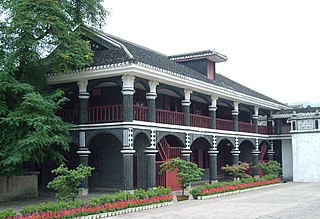| |||||
| Decades: | |||||
|---|---|---|---|---|---|
| See also: | Other events of 1905 History of China • Timeline • Years | ||||
Events from the year 1905 in China .
| |||||
| Decades: | |||||
|---|---|---|---|---|---|
| See also: | Other events of 1905 History of China • Timeline • Years | ||||
Events from the year 1905 in China .

Chiang Kai-shek was a Chinese politician, revolutionary, and military commander who was the leader of the Nationalist Kuomintang (KMT) party and commander-in-chief and Generalissimo of the National Revolutionary Army (NRA) from 1926, and leader of the Republic of China (ROC) in mainland China from 1928. After Chiang was defeated in the Chinese Civil War by the Chinese Communist Party (CCP) in 1949, he continued to lead the Republic of China on the island of Taiwan until his death in 1975. He was considered the legitimate head of China by the United Nations until 1971.

Zhou Enlai was a Chinese statesman, diplomat, and revolutionary who served as the inaugural premier of the People's Republic of China (PRC) from 1949 until his death in 1976, and concurrently as the inaugural Minister of Foreign Affairs from 1949 to 1958. Zhou was a key figure in the Chinese Communist Party (CCP) and ally of Mao Zedong during the Chinese Civil War, later helping consolidate its control, form its foreign policy, and develop the economy.

Chen Yun was a Chinese revolutionary leader who was one of the most influential leaders of the People's Republic of China during the 1980s and 1990s and one of the major architects and important policy makers for the reform and opening up period, alongside Deng Xiaoping. He was also known as Liao Chenyun (廖陈云), as he took his uncle's family name when he was adopted by him after his parents died.

The Zunyi Conference was a meeting of the Chinese Communist Party (CCP) in January 1935 during the Long March. This meeting involved a power struggle between the leadership of Bo Gu and Otto Braun and the opposition led by Mao Zedong. The result was that Mao left the meeting in position to take over military command and become the leader of the Communist Party. The conference was completely unacknowledged until the 1950s and still no detailed descriptions were available until the fiftieth anniversary in 1985.

The Shanghai massacre of 12 April 1927, the April 12 Purge or the April 12 Incident as it is commonly known in China, was the violent suppression of Chinese Communist Party (CCP) organizations and leftist elements in Shanghai by forces supporting General Chiang Kai-shek and conservative factions in the Kuomintang. Following the incident, conservative KMT elements carried out a full-scale purge of communists in all areas under their control, and violent suppression occurred in Guangzhou and Changsha. The purge led to an open split between left-wing and right-wing factions in the KMT, with Chiang Kai-shek establishing himself as the leader of the right-wing faction based in Nanjing, in opposition to the original left-wing KMT government based in Wuhan, which was led by Wang Jingwei. By 15 July 1927, the Wuhan regime had expelled the Communists in its ranks, effectively ending the First United Front, a working alliance of both the KMT and CCP under the tutelage of Comintern agents. For the rest of 1927, the CCP would fight to regain power, beginning the Autumn Harvest Uprising. With the failure and the crushing of the Guangzhou Uprising at Guangzhou however, the power of the Communists was largely diminished, unable to launch another major urban offensive.
Events in the year 1949 in China.
Events in the year 1950 in the People's Republic of China.
Events in the year 1952 in China.
Events in the year 1954 in China.

The Chinese Communist Revolution was a social revolution in China that began in 1927 and culminated with the proclamation of the People's Republic of China (PRC) in 1949. The revolution was led by the Chinese Communist Party (CCP), which afterwards became the ruling party of China. The revolution resulted in major social changes within China and has been looked at as a model by revolutionary Communist movements in other countries.
Events in the year 1942 in China.
Events in the year 1941 in China.
Events in the year 1900 in China.
Events from the year 1907 in China.
Events in the year 1944 in China.
Events from the year 1908 in China.
Events from the year 1897 in China.
The following lists events that happened during 1903 in China.
Events in the year 1896 in China.
The following lists events that happened during 1904 in China.